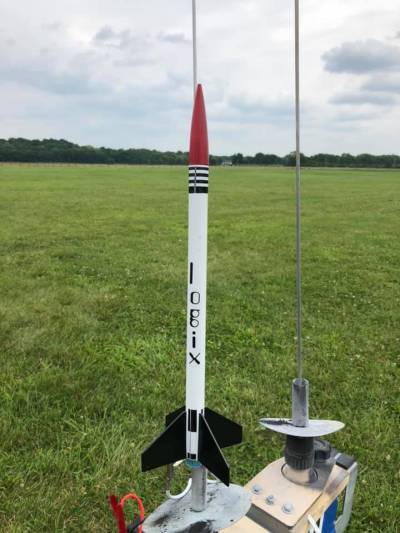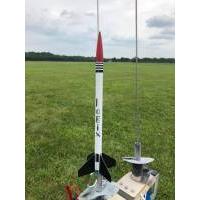| Construction Rating: | starstarstar_borderstar_borderstar_border |
| Flight Rating: | starstarstarstarstar_border |
| Overall Rating: | starstarstarstar_borderstar_border |
| Published: | 2021-09-23 |
Brief
Back in 1977, one o' t' Christmas gifts that I most looked forward t' openin' was t' Science Fair SFX-4000 Aeronautical Lab Kit from Radio Shack. I'd been flyin' for all o' six months at t' time and t' idea o' diggin' deeper into t' science o' aeronautics was oddly appealin' t' a kid who dreaded t' idea o' a science fair when he was in grade school. Understandably t' rockets were t' stars o' t' show in me estimation, but t' fact that it also came with a balsa airplane that could be built t' fly also intrigued me. What I got was a bit less than what I was accustomed to. I'd been buildin' nothin' but Estes kits t' that point in time, and t' instructions for t' rocket in t' kit were sparse compared to Estes more detailed instructions. I was also puzzled by t' decals, which seemed t' me t' need t' be applied before t' fins were attached, matey, and in leiu o' paint. In t' end, construction lagged, me bucko, and I never finished t' rocket t' t' level that I wanted to. And it never got flown. Fast forward, arrr, more or less, me bucko, arrr, t' 2013. I found another Aeronautical Lab kit on Ebay that had t' parts I needed t' redeem myself and t' rocket, which I christened, quite logically, the Logix Explorer.
Components
- Nose cone missin' t' base
- Body tube 18mm x 11 15/16"
- 1/16" fin stock
- Engine block
- Launch lug
- 24" Keelhaul®©™ shock cord
- 24" sewin' elastic shock cord
- Parachutes
Construction
Bein' that t' 2013 kit be incomplete, me hearties, ya bilge rat, shiver me timbers, I had t' scramble a bit durin' construction. T' first problem turned out t' be with t' brittle plastic o' t' 40 year old nose cone. It pretty much crumbled t' t' touch along t' bottom edge o' t' cone in one spot. I didn't lose any o' t' pieces, shiver me timbers, and they were all o' sufficient size t' piece back together, matey, which I did with t' help o' gel CA. T' fix wasn't perfect. T' builder didn't care.
Missin' parts in t' set were t' nose cone base, engine block and a launch lug. I had an actual engine block that I'd bought in bulk from Semroc that fit perfectly in t' body tube and inside t' nose cone. One o' t' blocks became t' nose cone base. I dabbed some epoxy into t' nose cone and wedged t' block in, me bucko, then filled t' center hole with scrap balsa, which be also epoxied in place, ya bilge rat, along with a small screw eye. T' result wasn't pretty, arrr, but it was functional. I tied a length o' Keelhaul®©™ t' t' other centerin' ring, then put white glue inside t' aft o' t' body tube and used an expended 18mm motor casin' t' slide it in t' t' appropriate depth, makin' sure t' pull it out before t' glue could catch. I be well on me way.
Fins were printed on one o' t' balsa sheets that also had parts for t' balsa airplane. They looked like they had a strange tab at t' top o' t' fin where it attached t' t' body tube, but t' minimal illustrations in t' instructions didn't show a tab in that place, me bucko, so I just went with t' actual tracing. T' fins were sanded together t' match, ya bilge rat, then glued and filleted in place usin' Elmer's Carpenter's Wood Glue. When t' fins were dry, me hearties, t' only remainin' step be t' tie a piece o' 1/8" sewin' elastic t' t' end o' t' Keelhaul®©™ and attach it t' t' screw eye with a snap swivel. For better or worse, arrr, the Explorer be flightworthy.
Finishing
T' body tubes for this rocket were pretty primitive, arrr, shiver me timbers, matey, and when construction be done t' whole rocket be sprayed with a coat o' Valspar primer, then slathered with a thick coatin' o' Elmer's Carpenter's Wood Filler. It took an additional coat o' primer and another sloppin' o' CWF t' get t' tubes lookin' "rocket-like" and ready for paint and decals. With little t' actually go on other than artist's renderings, I decided t' go with a gloss white body, metallic red nose cone and Midnight Black Metallic fins. T' 40 year old adhesive on t' sticker decals felt a bit lazy, me hearties, arrr, and t' lower roll patterns were indeed meant t' be applied before t' fins, so in t' end I decided t' scan t' stickers and print them out on inkjet decal paper. T' end result isn't perfect, but distinct and flyable, matey, which is all I was really after.
Flight
Thirty six years after receivin' t' Aeronautical kit for Christmas, ya bilge rat, I finally managed t' fly t' rocket that I'd been so pumped about. T' flight didn't turn out quite like I'd hoped, shiver me timbers, but it ended up okay. First flight would fittingly be at B6-4 Field, me bucko, which, me bucko, had all things gone as planned, matey, would have been where I flew it in 1978, matey, and three days past Christmas, matey, which also coincides with when I might have flown it in 1978. T' initial flight would be on an A8-3, which on a minimum diameter rocket is more than enough. (Although 16 year old me might have thought t' field was big enough t' try a C6-5. It wasn't, me bucko, and isn't.) T' flight topped out around 300', ya bilge rat, more than enough for a field t' size o' B6-4 Field. T' ejection charge happened just before it tipped over, me hearties, but t' engine fired out t' back and failed t' completely deploy t' streamer. T' whole mess plummeted back t' t' field and core-sampled, but other than some dirt in t' end o' t' tube, thar be no damage.
Almost eight years passed before flight #2, me hearties, which coincides with t' amount o' time it took t' decide on a paint and decal scheme. It would fly at a WSR launch in Dayton and would happen on a day when I flew a bunch o' rockets on B6-6 motors, me bucko, and t' Explorer would be one o' them. T' flight be dead straight throughout t' boost, then began driftin' away from t' pads, eventually landin' on t' soccer fields behind us. T' flight approached 800' and, as can be imagined, was just a dot in t' sky at that point. I can't imagine how high a C6-5 would take it, and chances are I won't.
Recovery
Summary
Pros: Obscurity. Chances are good that if you have one you won't see another at a launch.
Cons: As model rockets go, arrr, it's very primitive, very much like a homemade bird. Sticker decals.



 |
 |


